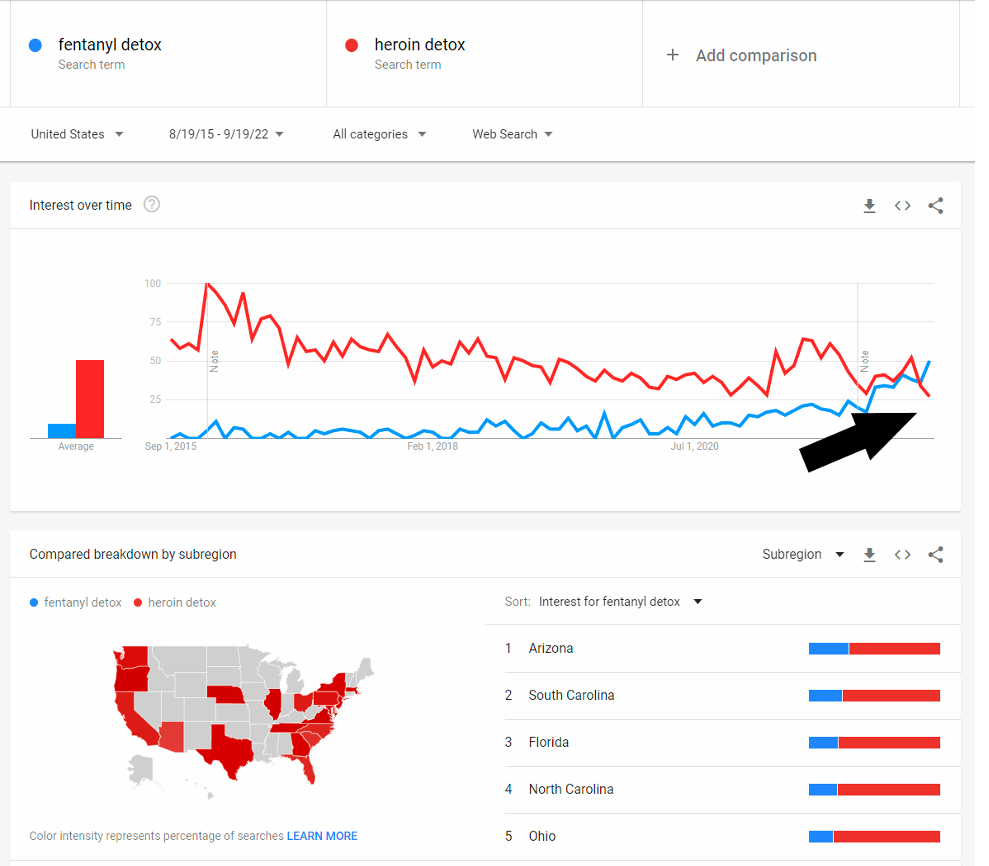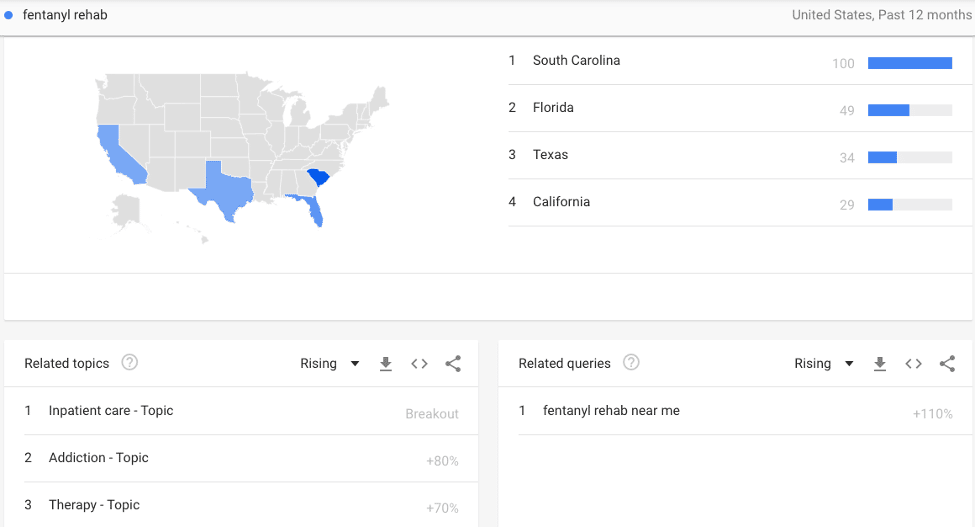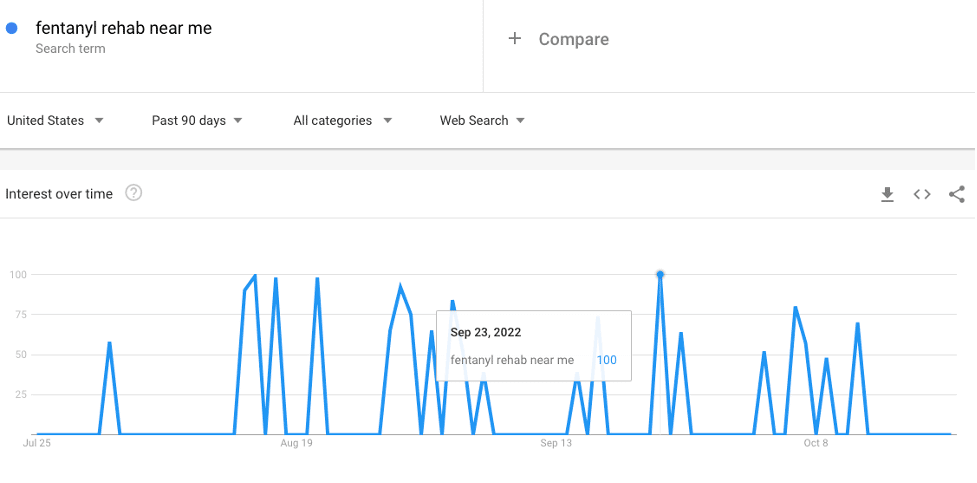Uncover Hidden Consumer Insights & SEO Opportunities with Google Trends
Google Trends is a powerful but underutilized tool that helps healthcare marketers
- Conduct search engine optimization (SEO) research,
- Identify current trends,
- Find out what people are interested in,
- And build better, more relevant campaigns.
It also allows marketers to analyze search term popularity over time, explore related keywords, and compare how search terms vary across different geographical areas.
In this article, you’ll learn:
- What Google Trends Is
- The Limitations of Google Trends
- 5 Ways to Use it For Your SEO strategy
What is Google Trends?
Google Trends is an online search tool that analyzes the popularity of top Google search queries across the globe.
It provides users with unbiased samples of Google search data that have been anonymized (no one is personally identified), categorized (organized by topic), and aggregated (grouped).
Marketers can leverage this data to determine geographical interest in particular topics and build highly relevant campaigns around them.
Limitations of Google Trends
The value Google Trends can provide has an important limitation, however. It only shares relative numbers and does not reveal actual search volume.
For example, you will not see that 18,467 people searched for “healthcare marketing” in September 2022. Instead, you will see how many people searched for that phrase compared to other months of the year.
Presenting data this way can be misleading because it ignores the big picture.
In addition to knowing whether a keyword or phrase is trending up or down, marketers need to know how popular the keyword or phrase is compared to other search terms to establish a baseline. There are two ways to achieve this:
- Search similar or related keywords or phrases
- Search known popular keywords or phrases
(Of course, you can use Google Trends in conjunction with other online tools that estimate specific search volume, such as SEM Rush or Google Ads Keyword Planner.)
Now that you know what Google Trends is and how you can use it to find objective data, let's explore a few tips and practical applications to help you effectively optimize your content strategy:
5 Tips to Supercharge Your SEO and Content with Google Trends
1. Review keyword traffic trends by time for deeper consumer insights
Identifying how a keyword trends over time is valuable for understanding whether marketers need to create new SEO content or pivot their strategy to meet their audience's changing interests.
Practical Application
According to new data from the Centers for Disease Control and Prevention (CDC), overdose deaths involving synthetic opioids (primarily fentanyl) increased by more than 13% between 2020 and 2021.
Google Trends recorded an uptick in search volume for “fentanyl rehab” in September 2022, aligning with this data.
In June 2022, searches for "fentanyl rehab" outpaced "heroin rehab" for the first time.

The trend for “heroin detox” vs. “fentanyl detox” is even more staggering.
At the time of this writing, Google Trends shows a consistent downward trend for “heroin detox” and a sharp upward trend for “fentanyl detox” beginning in the summer of 2020.
"Fentanyl detox" surpassed "heroin detox" for the first time last month, indicating massive search growth and SEO opportunities for addiction treatment centers and other healthcare marketers in this space.

2. Discover related keywords, topics and questions
Google trends helps identify additional relevant keywords based on your core search term using its features ‘related topics’ and ‘related queries.’
These features return related keywords or phrases in order of popularity, and the exact percent search volume increases for each.
Practical Application
- Related Topics
For example, Google Trends returned the following related topics for “fentanyl rehab:”- Inpatient care
- Drug overdose - epidemic
- Related Queries
Related queries are also search queries that share a concept, but instead of focusing on specific searches, it shares broader topics that are trending, like “fentanyl rehab near me.”

3. Capitalize on short-term or cyclical trends
Google Trends is invaluable for discovering which search terms are trending. By scaling your search parameters to a 90-day window, marketers can see which day or days trending search terms or phrases are most popular.
Practical application
For example, the top trending search query for "fentanyl rehab" is "fentanyl rehab near me." Narrowing the search to the last 90 days shows that these searches are most popular toward the end of the week (Thursdays, Fridays, Saturdays, and Sundays).
Knowing when there is likely to be a spike in interest is like uncovering a hidden gem for marketers. This information helps them plan and publish highly relevant content when their audience is searching for it.

4. Understand keyword context & keyword intent by category
With an estimated 3.5 billion daily searches and 1.2 trillion yearly searches worldwide, starting your keyword research with a broad keyword allows you to drill down and refine your data in several ways. They include:
- Worldwide
Expanding your search to include all countries allows you to identify which countries or continents are searching for particular topics. For example, the search volume for “drug rehab” is highest in Trinidad & Tobago and the United States. More on this next.

- Time
Google Trends offers search ranges from '2004 to the present,' to the past four hours. This allows users to vary time selections to get a broader picture of how a search term trends over a long period vs. a short period.
- Category
By refining search data by category, users can find more accurate information related to the topics they’re researching. For example, filtering by the “News” category parses search data for “drug rehab” with that specific search intent.
- Web Search Type
Users can filter and refine their data by several content types, including web, image, news, Google Shopping, and YouTube. For example, this helps identify search volume for "drug rehab" images.
5. Utilize keyword data by geography
Google Trends allows healthcare marketers to identify which geographic areas are best for promoting their products or services. This enables them to tailor content to these specific regions.
For example, “fentanyl rehab” is currently trending in Kentucky, Mississippi, and other southeastern states. Marketers in these areas can drill down to see which cities commonly search for treatment services and aim promotional activity (e.g., paid search ads, remarketing ads, social media posts) and localized content to those areas.
Incorporating geographic nuance into your content makes it more relevant to searchers, helping it rank better.
While Google Trends was not made explicitly for content marketers and SEOs, it can be a handy tool for keyword research and other marketing-related tasks.
The data is always current, so you’ll always have the freshest data on what’s trending in search.
Do you need help translating Google Trends data into consumer insights for your content marketing strategy? Contact the marketing experts at Healthcare Success. We can help turn your data into a relevant, engaging, and integrated marketing plan for your business.








